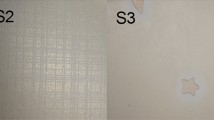Abstract
Wallpapers as the main decoration materials employed in the high-rise and civil buildings will cause fire when exposed to high temperature or high excessive current, which result in the loss of property and injuries. In order to reduce the fire risk caused by wallpapers, it is necessary to develop the study of wallpaper combustion behavior under different fluxes from 20 to 50 kWm−2 with 10 increments by fire propagation apparatus. In this study, three types of wallpapers (flame-retardant, water-proof and common) are investigated to deepen our understanding of vertical combustion behavior to reduce the fire risk of building caused by wallpaper fire. The visual observation, heat release rate, mass loss, ignition time, CO and CO2 yields, and TOC during the whole combustion process were analyzed to deepen the knowledge of combustion behaviors for different kinds of wallpapers. Flame-retardant and water-proof wallpapers will crack or bubble during the burning process. Under lower external heat flux, wallpapers will form charring layers during the burning process, while at high external heat fluxes, the formed charring layers will reduce to make combustion intensity fiercer. The formed charring layer will appear after burning for 10 to 20 s to inhibit the heat from the radiation and convection of the environment into sample to decrease combustion intensity. The transformed ignition time is linear with external heat flux, and the transformed index is equal to 1, which is consistent with thermal thin material. The CO2 yield of flame-retardant and common wallpapers is similar to CO yield except water-proof wallpaper, and with the fluxes increase, the gas yield of water-proof wallpaper increases first, then decreases and finally increases.
The results and experimental data in this study can provide guidance for the fire protection department to assess the fire risk of wallpapers and ensure the safety of people in the buildings.










Similar content being viewed by others
References
M. Park, G.-I. Kim and T.-G. Kim. A study on comprehensive fire risk analysis of wallpapers. Korean Institute of Fire Science & Engineering.2003;17 (1).
S.-G. Ham, H. Kim, S.-B. Han and U.-H. Kim. Smoke toxicity of interior materials used in apartments. Korean Institute of Fire Science & Engineering.2001;15 (3).
Shi L, Chew MYL. Influence of moisture on autoignition of woods in con calorimeter. J Fire Sci. 2012;30(2):158–69.
Kim JY, Lee JH, Kim SM. Estimating the fire behavior of wood flooring using a cone calorimeter. J Therm Anal Calorim. 2011;110:677–83.
Xin Y, Troup JMA, Advancements in fire hazard classification of roll papers, In: Proceedings of the fifth international seminar on fire & explosion Hazards, Edinburgh 2007
Ren N, Zeng D, Meredith K, Chaos M, Wang Y, CFD modeling of industrial-scale roll paper fires, In: Proceedings of the eighth international seminar on fire and explosion Hazards. Hefei, China, 2016, pp 25–28.
Wasan SR, Rauwoens P, Vierendeels J, Merci B. Study of vertical upward flame spread on charring materials –Part II: numerical simulations. Fire Mater. 2010;35:261–73.
Meng Q, Zhu G, Yu M, Pan R. The effect of thickness on plywood vertical fire spread. Procedia Eng. 2018;211:555–64.
Adetoyese Olajire Oyedun. Experimental modelling and optimisation of pyrolysis of solid wastes. PHD: The Hong Kong University of Science and Technology; 2014.
Ma Y, Wang J, Zhang Y. TG-FTIR study on pyrolysis of waster printing paper. J Therm Anal Calorim. 2017;129:1225–32.
Choi Y, Joe I, Lee S, Oh K. An experimental study on the ignition and emissions characteristics of wallpapers. J Mech Sci Technol. 2009;23:2839–47.
Shi L, Chew MYL. An experimental and numerical study on fire behaviors of charring materials frequently used in buildings. Energy Build. 2017;138:140–53.
Zhang X, Zhang T, Ding Z, Qiu T, Li C, Lu S. Combustion characteristic of commercial flame-retardant natural rubber under low oxygen atmosphere. Fire Technol. 2019;55:1691–705.
Ding Y, Wang C, Shouxiang L. Modeling the pyrolysis of wet wood using FireFOAM. Energy Convers Manag. 2015;98:500–6.
Ding Y, Ezekoye OA, Lu S, Wang C, Zhou R. Comparative pyrolysis behaviors and reaction mechanisms of hardwood and softwood. Energy Convers Manag. 2017;132:102–9.
Janssens M, Fundamental thermo physical characteristics of wood and their role in enclosure fire growth. PhD Thesis, University of Gent, Belgium, 1991.
Xin Y, Zeng D, Zhou X, Kristin J, Karl M. An experimental study of fire growth and suppression of roll paper at small scales. Fire Safety Journal. 2017;91:633–42.
Zhang Y, Zhang S, Wang Z. Crush behavior of corrugated cores sandwich panels. Adv Mater Res. 2011;217–218:1584–9.
Dong L, Zhu Y. Fire-resistant inorganic analogous xuan Paper with thousands of years’ super-durability. ACS Sustain Chem Eng. 2018;6:17239–51.
De Ris JL, Khan MM. A sample holder for determining material applications. Fire Mater. 2000;24:219–26.
ASTM E 2058–03 (2002) Standard test method for measurement of synthetic polymer material flammability using a fire propagation apparatus (FPA). American Society for Testing and Materials, 100 Barr Harbor Drive, West Conshohocken, PA, USA
Chen R, Lu S, Li C, Li M. Lo S Characterization of thermal decomposition behavior of commercial flame-retardant ethylene-propylene-diene monomer (EPDM) rubber. J Therm Anal Calorim. 2015;122:449–61.
Shi L, Chew MYL. Experimental study of carbon monoxide for woods under spontaneous ignition condition. Fuel. 2012;102:709–15.
Acknowledgments
This work was sponsored by Science and Technology Research Program of Chongqing Municipal Education Commission (Grant No. KJQN201901229 &KJQN202001213).
Author information
Authors and Affiliations
Corresponding author
Additional information
Publisher's Note
Springer Nature remains neutral with regard to jurisdictional claims in published maps and institutional affiliations.
Rights and permissions
Springer Nature or its licensor (e.g. a society or other partner) holds exclusive rights to this article under a publishing agreement with the author(s) or other rightsholder(s); author self-archiving of the accepted manuscript version of this article is solely governed by the terms of such publishing agreement and applicable law.
About this article
Cite this article
Zhang, X., Wang, Z., Chen, M. et al. Experimental study combustion behavior of wallpapers under different external heat fluxes. J Therm Anal Calorim 148, 2645–2656 (2023). https://doi.org/10.1007/s10973-022-11876-6
Received:
Accepted:
Published:
Issue Date:
DOI: https://doi.org/10.1007/s10973-022-11876-6




